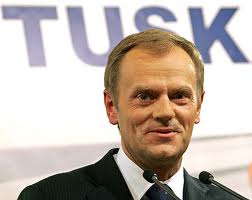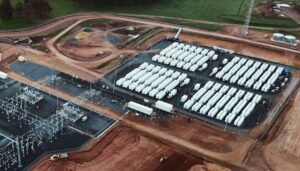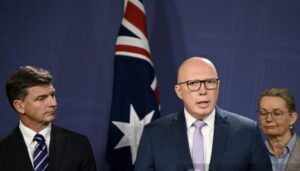Tony Abbott will no doubt continue his public war of words against the “great big new tax”, but he would quietly approve of the new de-facto minister for carbon pricing in the Australian cabinet – Donald Tusk, the prime minister of Poland.
Tusk is exactly the sort of prime minister of Poland that you would imagine Abbott would be, if he had an “inski” at the end of his name. Tusk doesn’t want to push on climate change because he wants the rest of the world to act first, he says carbon policies are a threat to an economy that relies so much on coal, he doesn’t like building wind and solar farms because he says it merely supports technologies that come from western European countries. Presumably, he doesn’t approve of washing machines or TVs either.
Tusk doesn’t have the National Party in tow, but he does have the Peasants Party, and it’s hard to spot the difference. Both assert that climate change and clean energy policies are “dangerous” for a country that relies so heavily on coal – more than 90 per cent, even more than Australia.
Tusk, in fact, has done more than anyone to hold up more ambitious climate change policies of the progressive nations on the continent – he has been able to veto moves to lift European emissions reduction targets, veto a proposal for a more ambitious continent-wide renewable energy target, and veto moves to rid the massive overhang of phantom credits that has swamped the EU carbon market.
He has, single-handedly, made the EU climate policies all but useless – a fact that is celebrated in Poland. “It’s a toothless tiger,” a senior Polish diplomat said recently of the ETS. “Nobody will dare to chop this tree down, but we will be shaking it until it loses all its leaves.” That’s a sound-bite right out of the Abbott vestibule.
Australia has now bought into that political mess and hitched a ride on European carbon cavalcade by aligning its carbon trading scheme with Europe. This is not to say that Australia’s decision to drop the carbon floor price and link to Europe’s was the wrong one. But like so much of the debate that has characterized the climate change policy arena, it is one borne out of expediency and compromise, and possibly for the wrong reasons.
In the current domestic context, it is seen as smart politics. It effectively neutralises the business lobby, defuses the political debate, and invited Abbott to take the bait and adopt an even more extreme position. Mr “No” obliged. He now has even less room to manouvre. The political pundits that make their living in Canberra are duly sated, at least for the moment.
But unless the government’s budget numbers are to be blown out of the water, then Canberra needs to hope that pressure can be brought to bear on Poland’s PM, and that at least two of those troika of policies that he has so far neutered can make progress– at the very minimum it needs the massive overhang of surplus credits to be removed or delayed. Otherwise, once the fixed price period ends in 2015, its own carbon price will fall to a similarly useless level as Europe’s.
This may satisfy “business”, but it underlines the critical importance of the “complementary” policies that will be the next target of the unrelenting forces opposed to change, unless it comes with a hefty compensation package. Chief among these is the Renewable Energy Target. A lower carbon price means there is no hope at all of substituting gas for coal. Without the RET, a low carbon price means that Australia will do not much transitioning at all.
But the low carbon price means that renewable energy certificates (RECs) will be more expensive to bridge the difference in the upfront capital costs of wind and solar farms. (The difference between the current cost of coal and renewables is made up from a combination of the carbon price and the RECs price. If one falls, the other rises). That does not make much difference to consumers, but it could be tempting for energy utilities to pay a penalty price on the RECs rather than go to the trouble of building something useful. The RET needs to be retained, and it escape clauses need to be strengthened.
Because of their own frustration with the EU ETS, leading European economies have taken their own additional measures to effect a transition to a low carbon economy, and to ensure that they remain competitive with the Asian economies and their Asian counterparts, who are dominating the clean energy markets. England has introduced an additional carbon price for its energy sector, on top of a renewable energy target and generous feed in tariffs. Germany has accelerated its exit from nuclear and is pushing for the most ambitious transformation to a renewables-dominated electricity grid. Ireland, Spain and the Scandinavian countries all have supplementary measures to add to their low carbon opportunities.
And that’s the tricky position for Australia. It is located in the heart of the Asia-Pacific region, which is competing so vigorously to champion clean energy technologies, and gain the dominant role in what the head of GE last week described as a $6 trillion market. Asian countries that are considering emissions trading schemes are unlikely to introduce schemes that are so patently compromised as that of Europe’s – the Californian scheme that comes into effect in a few months has an effective floor price and no permits from international markets for that very reason.
These were all considerations when Australia went through the laborious process of designing its own scheme that was supposed to draw from the experiences and lessons of Europe. That explains the “cautious” welcome given to Combet’s announcement by advocacy groups. Actually, they think it’s pretty stupid, but are so thankful of having a carbon price at all, and so terrified by what Abbott might do to it, that even a compromise is acceptable.
So now we’ve exported sovereignty over carbon pricing to Poland, in a continent in the midst of a recession. If any media organizations in Australia had any money it would be worth opening a bureau in Warsaw. An Australian reporter is likely to see some familiar faces checking in to lobby in the corridors of power – Mitch, Greg, Matthew, Oh, look, there’s Jennifer. And the Peasants Party should invest in a new set of napkins – the luncheon menu is set.









